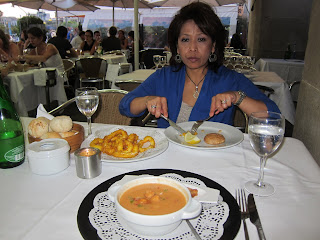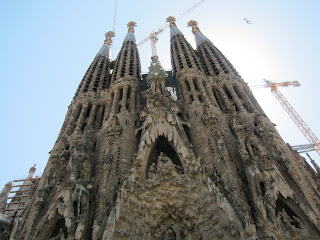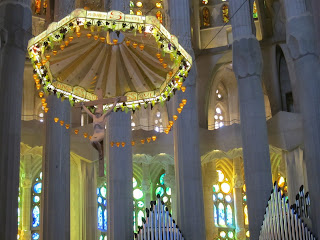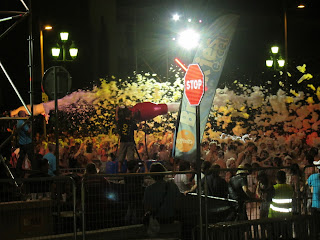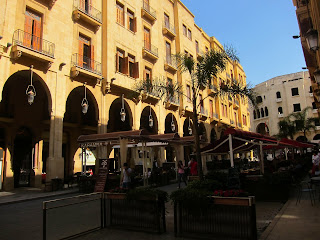On the ride into the city it was clear that this place was different.
Yes there was the sunshine, the blue sky, the palm trees, the sparkling Mediterranean, but this was no longer the Middle East, this was the European Med.
This was now Spain, or more specifically Barcelona.
We had made the trip so the Skipper could attend the "ESMO World Congress on Gastrointestinal Cancer", and to catch up on a little R&R away from the Magic Kingdom.
Several disreputable souls from the Magic Kingdom who were sponsored by Roche Pharmaceuticals.
Barcelona is an old city, sitting on the shores of the western Mediterranean, although not as old as Beirut which we visited several weeks ago. It had its share of cultures from the Carthaginians, to the Romans, to the Moors who were eventually kicked out to make way for the present Spaniards. It was the city to which Columbus returned from his adventures "discovering" the New World when he brought back several Carib natives with him for display. Subsequent to that Spain became a major world power exploiting many parts of the world, although the French and the British eventually put an end to that. Today we think of its sunny beaches, vineyards, bull fights, Barcelona FC football club, flamenco dancers, cafes, and night life, as well as its historical culture. Barcelona is now Spain's second major city after Madrid.
Foremost to us however it is a Mediterranean city.
Boats on the Med (telephoto from our hotel window) - a body of water with a vast maritime history.
The Skipper & Admiral awaiting our dinner after examining the fleet. This is part of Port Vell, an extension of the old town, clearly modern now.
The old Port Vell area has been developed for strolling with its cafes and modern marine facilities for boats clearly part of the scene.
Dining by the harbor. We elect for typical local specialties such as this Gazpacho soup, calamari, and paella to come. At other times during our visit we also ate Italian and Mexican food - remember it was the Spaniards who made Mexico part of their empire for a while. During our time here we also indulged in other liquid refreshments ranging from Sangria to Rioja.
The harbor is a beautiful area for strolling, with a mixture of traditional and modern sailing vessels.
This "classic modern" schooner sits opposite a number of larger power yachts also fairly common here.
Just up from the harbor, abutting the old town, one can see that the major road running along the sea front is dropped below ground level, allowing a more pleasant promenade with frequent walking bridges crossing over to the harborfront.
Further up the coast, going toward our hotel and conference centre, there are several beaches. Not seen here are the many woman that remain topless on these beaches - yes this is the European Med!
Along the beach areas are many modern apartments & condos - quite expensive, even by Toronto standards. The cost of living in the Euro Zone is quite high, although a German couple we met thought it was "cheap" in Spain - maybe in the old days - I guess it's all relative.
Yes Barcelona is a city by the sea, but it is also so much more. The city has an excellent transportation system, likely modernized for the Olympic Games it hosted a few years back. However it also has an excellent bus service such as this one which is set up for tourists, who for one daily fare can go on three major routes throughout the city, getting on and off at one's leisure so as not to rush. A great way to see the city. Obviously sitting up top in the open air is the most fun.
A trip into the old town via this bus service. This is just up from the old harbor area we visited.
The Barcelona Cathedral. This was begun in 1298 on the foundations of a Roman temple and a Moorish Mosque. However it was not finally completed until the last century.
Part of the interior roof of the Barcelona Cathedral.
There are many narrow interesting streets for exploring the old town.
La Rambla street is one of the most famous streets for strolling in Spain. Many interesting sights.
Part of strolling along La Rambla. This is a historic avenue that runs through the old town down to the harbor. It is active day and night. There are many old buildings, cafes, bars, stores, markets, and other entertainment.
A large fruit, vegetable & other food market running off La Rambla street.
Another view of La Rambla street. Of note the large number of trees present on many of the streets, even in the old town. The locals, as well as tourists, love to get out and walk - living cities.
As noted, La Rambla eventually ends at the harbor.
Many beautiful vistas while strolling.
Off on the bus again - need to visit one of Barcelona's most famous landmarks. From an artistic point of view we have heard of Picasso (the museum here we missed) but what about Gaudi?
This is viewing the upper part of Gaudi's masterpiece, the Sagrada Familia. It is reputed to be Europe's most unconventional Church and an emblem of Barcelona, a city that thinks of itself as individualistic. Gaudi started its development in 1883 and it is still being built, but according to his design! Gaudi is buried in the crypt. The front and back entrances of the church have quite different designs & themes. This is the front. Note the cranes for its ongoing construction. Visitors fees help pay for the construction.
Over the front entrance is the "Passion Facade", which depicts the sufferings and execution of Jesus.
The opposite entrance to the "Sagrada Familia" Church is a very different design.
The facade over this entrance is called the "Nativity Facade". The central part of the facade is pictured here. Its style is different from the "Passion Facade" at the other entrance.
Part of this facade depicting the Three Wise Men.
Part of the interior just inside the main entrance. An eclectic mix.
The stained glass windows are not what is expected of a church like this one - a modern design, rather than pictorial images.
Further images - unusual chandelier?
How about the ceiling? Vegetation in stone? Two images next to each other. Note the circular (black) stairway going up, shown in the bottom central portion of the lower image.
An alternate, more modern view of Barcelona architecture. Almost surreal in this evening light.
Opposed to the modern architecture, is what is more to be expected of an old European city.
This view is looking up at the "Museu Nacional d'Art de Catalunya", which is not only a museum but also houses a nice restaurant (in the windows seen above) where our small group from Saudi Arabia ate dinner - a spectacular view of the city below as this sits on a hill.
The view from "Montjuic", actually from the steps in front of the museum.
The same view with the "dancing fountains", seen beyond the pillars in the foreground. These fountains change their height, shape and pattern with a classical music background. As it gets dark they are colored with different lights. This view could be seen from the restaurant window.
View from the restaurant as the night began to close in on the evening.
The ceiling in the museum restaurant had an interesting feature with an angled mirror attached to catch a view of the dining room. The classical structure next to the modern mirror was quite a contrast.
The view of the ceiling on looking up from our table!
The last evening view from our table before walking down the steps beyond the fountain, where we observed a street concert / disco going on - with a twist.
This is the live concert going on beyond the "dancing fountain". Those are "soap suds" being sprayed out at the participants listening and dancing! As can be seen by the "stop" sign they have closed that part of the road for the event.
Yes "soap suds" - hope they have a change of clothes?
So with that we end our trip. The conference was good, and the R&R greatly appreciated.
The Med has that special feel, a different sense of life, of living more in the moment. whether on the Eastern or Western shores.
Yes it was another opportunity to put feet in the sand. Beyond the sand is the sea, and beyond that another horizon, a place to focus on to view more distant shores.
Stay tuned.
Thursday, June 30, 2011
Thursday, June 16, 2011
A Trip to the Levant, Meanderings, and Back in the Mists of Time.
It was a direct flight from Jeddah to Beirut, two & half hours, and a different world again. Another weekend escape, a celebration of life, having just past the skipper's 64th birthday. As the plane hit the runway one considered the contradictions inherent in this country of Lebanon. Historically this was part of the Levant, a region encompassing the Eastern shores of the Mediterranean. Beirut, the capital of Lebanon, is truly a Mediterranean city, part of the Middle East, but with both an Arab and European history and influence. The taxi driver that took us to our hotel could have spoken English, Arabic as well as French, but that is getting ahead of ourselves.
Beirut is an ancient city, being first mentioned by the ancient Egyptions about 1500 B.C. The coast of Lebanon itself was in those days the land of the Phoenicians, a great maritime trading culture. They continued with their great seafaring activities for over a thousand years, until Alexander the Great carried out a bloody conquest of this region on his way to expanding his empire. During biblical times this was the land of the Canaanites. Subsequently the Greeks, the Romans, the Crusaders (with their wars fighting Muslims in the Holy Land), the Ottomans(from Turkey), and the French all had their turns at influence and occupation until the recent independence came in 1943 during the second world war. In the 1960's Beirut achieved the label of the "Paris of the East". Then in the 1970's the civil war started, lasting for over a decade, resulting in much destruction & turmoil. It was only well into the 1990"s that significant rebuilding started taking place. Despite this it is still a city of contradictions with the impoverished Palestinian refugee regions, the Hezbollah and the poor in the south reaching to the border of Israel, in contrast to the many expensive housing projects, particularly by the sea, and its reputation for its myriads of restaurants, cafes, bars, and bustling extravagent nightlife.
Our hotel was in the Hamra district of Beirut, an older but fairly central part of the city. After checking in Jim, Joy and myself went walking in the neighborhood passing many bars, cafes & restaurants until we found a sidewalk French Cafe, that interestingly specialized in pasta. However the food was great and the wine went down well! No diets on this trip. After a late night we were up early to go exploring - no rest on this trip.
The view from our hotel room in the Hamra District of Beirut. At the far end of the picture one can just see the blue of the Mediterranean sea.
Out on Hamra Street. Looking for coffee.
Although Turkish coffee is historically popular, standard chains are everywhere. No complaints here.
Continued street meanderings. A cross between an Arabic & European Mediterranean city.
Cutting down a back street on our way toward the sea and the American University of Beirut.
A typical older shuttered home seen on our stroll. As one gets closer to the water more of these are being torn down to make way for more "modern", and expensive, apartments and condos.
A student area as we approach the American University of Beirut, the building seen on the left, across the street, is an entrance.
The entrance to the University. This is one of the premier institutions in the region.
After what the citizens have gone through, and continue to endure, higher education is seen as a means to a better future. However many graduates move overseas for their employment creating a brain drain. Yes Lebanese professionals are seen working worldwide.
Part of the central campus of the American University of Beirut.
The campus runs down to the Mediterranean. Tough location!!
We reach the shores of the Mediterranean. This is its most eastern location, looking west. This view is from the corniche that runs along the waterfront of Beirut. The horizon beckons, as it has done for thousands of years.
The skipper, Jim and Tord decide on our route - lots of walking this day. Beautiful weather.
The corniche and rocky shoreline. Many new apartment condos are being built along the waterfront - at great cost! The rich citizens here live a very different life from the displaced Palestinians for example.
New construction near the waterfront in contrast to the fishermen.
A lone fisherman carrying out an activity for the ages. Yes I saw him catch a reasonable sized fish.
The modern generation use the sea side in other ways - beaches are elsewhere on the coast. This is next to the corniche.
A telephoto lens does wonders - these guys are smoking shischa, very popular in the Middle East, by the sea shore. They will likely be out at the night clubs after dark.
Pigeons' Rocks - a famous landmark on the Beirut waterfront.
Time for lunch by the sea - not bad slumming. All the food we had in Lebanon was good. The cold beer also went well with lunch after all that walking in the sun.
The Mediterranean relaxed lunch prevails - even the women here take time for their shischa.
Time to continue our walkabout. This statue has bullet holes in it from the civil war (may have to enlarge the picture to see them well). There is also a Holiday Inn close by to this site which underwent extensive damage from the war and has been left to stand despite the years that have passed - a modern monument to chaos??
An image to history. This mosque (Muslim), church (Christian), side by side had their origins nearly a thousand years ago, dating around the time of the crusades. In Lebanon many faiths are practiced including Muslim, Christian and Judaism. In the foreground are Roman ruins from their time of occupation two thousand years ago.
Further evidence of Roman ruins with the city growing up around this preserved site. These were Roman Baths.
Renovations of the older buildings here insstead of demolition and rebuilding. Great place to walk.
In this renovated area, close to government buildings, they have closed off the streets to allow open pedestrian walking and restaurants in the street. During the day it is quiet but I am sure when the sun goes down it becomes lively as does much of the city.
It is now time to take a trip out of Beirut. We hired a driver the second day to take the five of us North to the city outskirts and beyond for a day trip.
Just North of Beirut we take the cable car up to the mountain top (mountains run up the coast) at Jounien to the mountaintop Basilica of Our Lady of Lebanon. The view is spectacular.
The last part of the ascent is via a tram car - much like going up the mountains in the Alps.
The view from the top. The patio below to where I am required climbing stairs to the final platform. Although Beirut proper has ended, the cityscape seen below is part of urban sprawl going up the coast.
Oh did I mention that I am scared of heights - a swinging gondola dosn't help that situation!
Finally coming down (a view from the gondola) - the highway below runs up the coast, and will be our route for going further North to the ancient seaside town of Byblos.
Byblos, our next destination, was the biblical Gebal. The town site apparently had initially been inhabited 7000 years ago, and had become an important Phoenician port town about 3500 years ago.
Of note Carthage in North Africa was also a Phoenician settlement initially. As with many places in the region it was subsequently inhabited by ancient Greeks, Romans, Crusaders, and Ottomans. The evidence for some of this is still present and excavations are continuing. At present it is a very pretty still somewhat laid back old port town - at least the old part which we were to visit.
Our driver dropped us off, and we walked through the old town of Byblos. The wall on the right likely originated from the time of the crusaders.
The boat ramp into the small harbor at Byblos. The building in the center background houses the "Byblos Fishing Club" where we ate a wonderful sea food lunch. Eating good food is easy here. The Crusader's Castle can also be seen in the background just right of center.
The entrance to the restaurant at least has a nautical theme - nice for the skipper & admiral.
A lunch worthy of Neptune's table. The restaurant has its own fishing boats and catch their own seafood. The diners go to the back and pick which of the catch you wish, then "voila" they cook it and serve it. This along with some Lebanese appetizers & salad & cold beer - no rush, just enjoy, with a view from this open air restaurant overlooking the harbor.
A view of the Medieval Harbor from our restaurant table. Hard to believe such an important harbor town in history was so smaall.
Fishing boats in the harbor. Note the Mediterranean mooring.
Steps up to the Crusadrer's Castle. Subsequently used by the Ottomans.
Entering the castle - relatively good condition considering it was built around 1100AD.
Medieval castles are fascinating places.
A view from the top of the castle, looking out at the Mediterranean, and the Roman ruins in the foreground. Roman pillars can still be seen standing. Apparently this was a large Roman outpost town in its day.
Unfortunately the builders of this Medieval Crusaders Castle scavanged many parts from the old Roman town. You can see that in building the castle they cut up Roman columns to help with the construction of the castle wall.
Fortunately a part of this Roman amphitheatre remains. The stage is in front with a back drop of the Mediterranean - spectacular.
A once majestic site left to the march of time. Apparently there was a collonade of pillars.
Yes it was a great trip. A beach on the coast can be seen in the background to the left side of the picture. This caters to the hotels and people on day trips to the "new" town of Byblos. The "old town" however was much better for us.
Unfortunately it is now time to go home.
This is Jeddah from our arrival flight at night - in the morning it's off to work again. Next week, assuming the ash from the recent volcano eruption in Eritrea doesn't ground us, we will be off to the other end of the Mediterranean.
Stay tuned.
Beirut is an ancient city, being first mentioned by the ancient Egyptions about 1500 B.C. The coast of Lebanon itself was in those days the land of the Phoenicians, a great maritime trading culture. They continued with their great seafaring activities for over a thousand years, until Alexander the Great carried out a bloody conquest of this region on his way to expanding his empire. During biblical times this was the land of the Canaanites. Subsequently the Greeks, the Romans, the Crusaders (with their wars fighting Muslims in the Holy Land), the Ottomans(from Turkey), and the French all had their turns at influence and occupation until the recent independence came in 1943 during the second world war. In the 1960's Beirut achieved the label of the "Paris of the East". Then in the 1970's the civil war started, lasting for over a decade, resulting in much destruction & turmoil. It was only well into the 1990"s that significant rebuilding started taking place. Despite this it is still a city of contradictions with the impoverished Palestinian refugee regions, the Hezbollah and the poor in the south reaching to the border of Israel, in contrast to the many expensive housing projects, particularly by the sea, and its reputation for its myriads of restaurants, cafes, bars, and bustling extravagent nightlife.
Our hotel was in the Hamra district of Beirut, an older but fairly central part of the city. After checking in Jim, Joy and myself went walking in the neighborhood passing many bars, cafes & restaurants until we found a sidewalk French Cafe, that interestingly specialized in pasta. However the food was great and the wine went down well! No diets on this trip. After a late night we were up early to go exploring - no rest on this trip.
The view from our hotel room in the Hamra District of Beirut. At the far end of the picture one can just see the blue of the Mediterranean sea.
Out on Hamra Street. Looking for coffee.
Although Turkish coffee is historically popular, standard chains are everywhere. No complaints here.
Continued street meanderings. A cross between an Arabic & European Mediterranean city.
Cutting down a back street on our way toward the sea and the American University of Beirut.
A typical older shuttered home seen on our stroll. As one gets closer to the water more of these are being torn down to make way for more "modern", and expensive, apartments and condos.
A student area as we approach the American University of Beirut, the building seen on the left, across the street, is an entrance.
The entrance to the University. This is one of the premier institutions in the region.
After what the citizens have gone through, and continue to endure, higher education is seen as a means to a better future. However many graduates move overseas for their employment creating a brain drain. Yes Lebanese professionals are seen working worldwide.
Part of the central campus of the American University of Beirut.
The campus runs down to the Mediterranean. Tough location!!
We reach the shores of the Mediterranean. This is its most eastern location, looking west. This view is from the corniche that runs along the waterfront of Beirut. The horizon beckons, as it has done for thousands of years.
The skipper, Jim and Tord decide on our route - lots of walking this day. Beautiful weather.
The corniche and rocky shoreline. Many new apartment condos are being built along the waterfront - at great cost! The rich citizens here live a very different life from the displaced Palestinians for example.
New construction near the waterfront in contrast to the fishermen.
A lone fisherman carrying out an activity for the ages. Yes I saw him catch a reasonable sized fish.
The modern generation use the sea side in other ways - beaches are elsewhere on the coast. This is next to the corniche.
A telephoto lens does wonders - these guys are smoking shischa, very popular in the Middle East, by the sea shore. They will likely be out at the night clubs after dark.
Pigeons' Rocks - a famous landmark on the Beirut waterfront.
Time for lunch by the sea - not bad slumming. All the food we had in Lebanon was good. The cold beer also went well with lunch after all that walking in the sun.
The Mediterranean relaxed lunch prevails - even the women here take time for their shischa.
Time to continue our walkabout. This statue has bullet holes in it from the civil war (may have to enlarge the picture to see them well). There is also a Holiday Inn close by to this site which underwent extensive damage from the war and has been left to stand despite the years that have passed - a modern monument to chaos??
An image to history. This mosque (Muslim), church (Christian), side by side had their origins nearly a thousand years ago, dating around the time of the crusades. In Lebanon many faiths are practiced including Muslim, Christian and Judaism. In the foreground are Roman ruins from their time of occupation two thousand years ago.
Further evidence of Roman ruins with the city growing up around this preserved site. These were Roman Baths.
Renovations of the older buildings here insstead of demolition and rebuilding. Great place to walk.
In this renovated area, close to government buildings, they have closed off the streets to allow open pedestrian walking and restaurants in the street. During the day it is quiet but I am sure when the sun goes down it becomes lively as does much of the city.
It is now time to take a trip out of Beirut. We hired a driver the second day to take the five of us North to the city outskirts and beyond for a day trip.
Just North of Beirut we take the cable car up to the mountain top (mountains run up the coast) at Jounien to the mountaintop Basilica of Our Lady of Lebanon. The view is spectacular.
The last part of the ascent is via a tram car - much like going up the mountains in the Alps.
The view from the top. The patio below to where I am required climbing stairs to the final platform. Although Beirut proper has ended, the cityscape seen below is part of urban sprawl going up the coast.
Oh did I mention that I am scared of heights - a swinging gondola dosn't help that situation!
Finally coming down (a view from the gondola) - the highway below runs up the coast, and will be our route for going further North to the ancient seaside town of Byblos.
Byblos, our next destination, was the biblical Gebal. The town site apparently had initially been inhabited 7000 years ago, and had become an important Phoenician port town about 3500 years ago.
Of note Carthage in North Africa was also a Phoenician settlement initially. As with many places in the region it was subsequently inhabited by ancient Greeks, Romans, Crusaders, and Ottomans. The evidence for some of this is still present and excavations are continuing. At present it is a very pretty still somewhat laid back old port town - at least the old part which we were to visit.
Our driver dropped us off, and we walked through the old town of Byblos. The wall on the right likely originated from the time of the crusaders.
The boat ramp into the small harbor at Byblos. The building in the center background houses the "Byblos Fishing Club" where we ate a wonderful sea food lunch. Eating good food is easy here. The Crusader's Castle can also be seen in the background just right of center.
The entrance to the restaurant at least has a nautical theme - nice for the skipper & admiral.
A lunch worthy of Neptune's table. The restaurant has its own fishing boats and catch their own seafood. The diners go to the back and pick which of the catch you wish, then "voila" they cook it and serve it. This along with some Lebanese appetizers & salad & cold beer - no rush, just enjoy, with a view from this open air restaurant overlooking the harbor.
A view of the Medieval Harbor from our restaurant table. Hard to believe such an important harbor town in history was so smaall.
Fishing boats in the harbor. Note the Mediterranean mooring.
Steps up to the Crusadrer's Castle. Subsequently used by the Ottomans.
Entering the castle - relatively good condition considering it was built around 1100AD.
Medieval castles are fascinating places.
A view from the top of the castle, looking out at the Mediterranean, and the Roman ruins in the foreground. Roman pillars can still be seen standing. Apparently this was a large Roman outpost town in its day.
Unfortunately the builders of this Medieval Crusaders Castle scavanged many parts from the old Roman town. You can see that in building the castle they cut up Roman columns to help with the construction of the castle wall.
Fortunately a part of this Roman amphitheatre remains. The stage is in front with a back drop of the Mediterranean - spectacular.
A once majestic site left to the march of time. Apparently there was a collonade of pillars.
Yes it was a great trip. A beach on the coast can be seen in the background to the left side of the picture. This caters to the hotels and people on day trips to the "new" town of Byblos. The "old town" however was much better for us.
Unfortunately it is now time to go home.
This is Jeddah from our arrival flight at night - in the morning it's off to work again. Next week, assuming the ash from the recent volcano eruption in Eritrea doesn't ground us, we will be off to the other end of the Mediterranean.
Stay tuned.
Subscribe to:
Comments (Atom)




